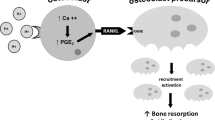Summary
Humans generally consume a diet that generates metabolic acids leading to a reduction in the concentration of systemic bicarbonate and a fall in pH. In vitro experiments indicate that this metabolic acidosis causes a release of calcium from bone that initially is simply due to physicochemical dissolution of the mineral. On a more chronic basis metabolic acidosis alters bone cell function; there is an increase in osteoclastic bone resorption and a decrease in osteoblastic bone formation. Concomitant with the dissolution and resorption of the bone mineral there is buffering of the addition protons by bone leading to restoration of the systemic pH. Interestingly respiratory acidosis, caused by an increase in the partial pressure of carbon dioxide induces far less bone dissolution and resorption and the additional hydrogen ions are not buffered by bone. As we age we are less able to excrete these metabolic acids due to the normal decline in renal function. We hypothesize that a slight, but significant, metabolic acidosis leads to greater loss of bone mineral and increase potential to fracture.
Similar content being viewed by others
Author information
Authors and Affiliations
Additional information
Received: 13 September 2001, Accepted: 20 September 2001
Rights and permissions
About this article
Cite this article
Bushinsky, D. Acid-base imbalance and the skeleton. Eur J Nutr 40, 238–244 (2001). https://doi.org/10.1007/s394-001-8351-5
Issue Date:
DOI: https://doi.org/10.1007/s394-001-8351-5




